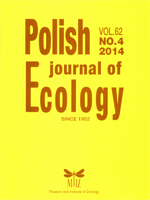Trichocerca simoneae De Smet described in 1989 has since been found in tropical and subtropical areas, but was not recorded in Poland before World War II. A bibliography of Polish rotifers by Wiszniewski (1953), although very comprehensive, does not refer to T. simoneae. However, in the studies of plankton of the dystrophic lake, i.e. humic one with water rich in humic acids, acidic pH and brown coloured, carried out in the years 1998–2000, the species dominated. Here, studies in 39 small, inter-forest lakes of north-eastern Poland revealed T. simoneae in 15 of them, often at high densities, up to ca 6000 ind L-1. The possible reasons for this ‘invasion’ are: (1) zooplankton communities in dystrophic lakes are unsaturated with biotic interactions too weak to exclude invaders; CCA and RDA analyses showed that T. simoneae preferred habitats with low number of zooplankton species of low density and dystrophic lakes seem to offer such habitats; (2) long-term deposition of rotifer resting eggs is probably more successful in sediments decaying at low rates. The latter possibility seems to be confirmed by observed in the littoral zone of dystrophic lakes appearance from time to time, of rare, mostly tropical species of Rotifera (e.g., Lecane hornemnni, L. monostyla, L. sola).
How to translate text using browser tools
1 December 2014
Rotifer Invasion? On Appearance and Abundance of Tropical Species in Lakes of North-Eastern Poland
Jolanta Ejsmont-Karabin
ACCESS THE FULL ARTICLE
<
Previous Article
|

Polish Journal of Ecology
Vol. 62 • No. 4
December 2014
Vol. 62 • No. 4
December 2014
dystrophic lakes
exotic species
invasion
Rotifera




